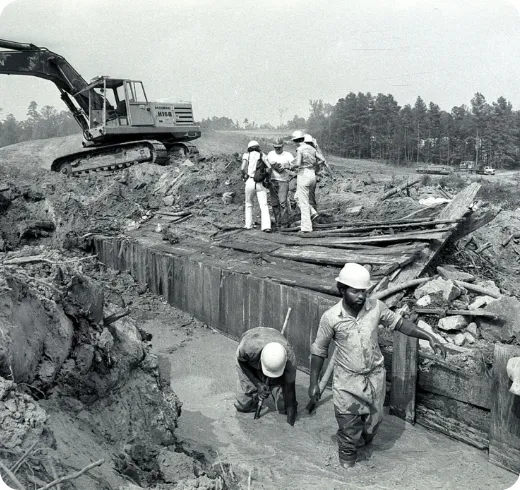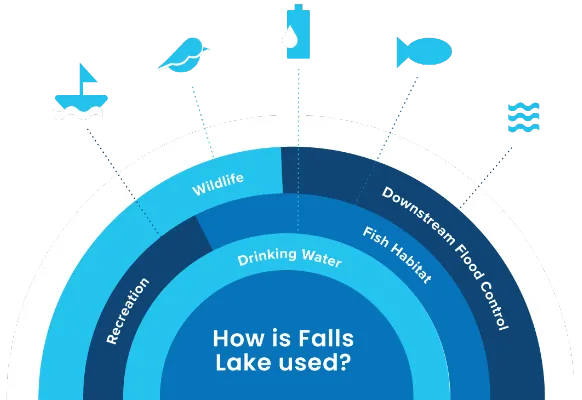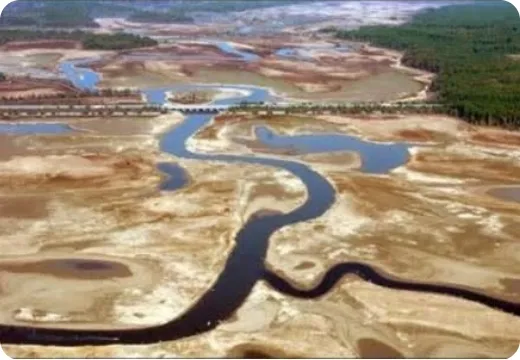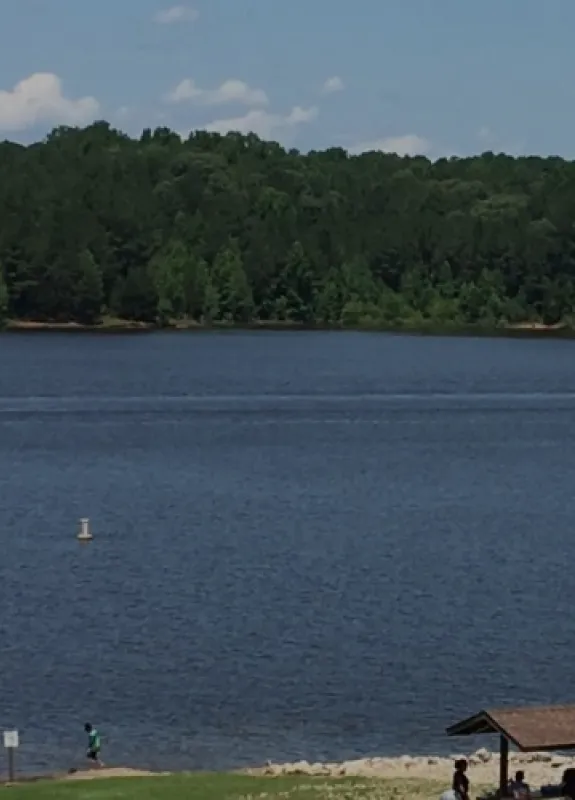
About us
Construction and Early Studies
Falls Lake Reservoir was constructed in the late 1970s. The lake was filled in the early 1980s. Water quality studies predicted the lake would be eutrophic (producing too much algae). Algal growth today is below originally predicted levels.
The early studies also indicated the lake would provide important uses. These are called designated uses and include drinking water supply, recreational use, aquatic life use, and flood control.

Uses of the Lake
Falls Lake is meeting its intended uses and provides the following:
- Flood control for downstream communities
- A water supply for over half a million customers
- A regional recreational resource for swimming, fishing, and boating
- Habitat to aquatic and terrestrial wildlife
Addressing Nutrients
Nutrients (nitrogen and phosphorus) are naturally occurring elements that cycle through the environment. Appropriate amounts are necessary for a healthy ecosystem. High nutrient inputs can cause problems, but Falls Lake is meeting its uses.
In 2011, state regulators adopted the Falls Lake Rules. Regulated entities under these Rules have significantly reduced nutrient loading to Falls Lake. Further reductions will be difficult because conditions have changed.
The UNRBA has developed recommendations to update the nutrient management strategy. This approach would improve water quality in the watershed and Falls Lake.
View the links below for additional information on nutrient loading to Falls Lake:
- Historic trends in total nitrogen and total phosphorus loading to Falls Lake
- Importance of precipitation on delivered nutrient loading to Falls Lake
- Percent contributions from watershed sources on delivered nutrient loading to Falls Lake
- UNRBA Watershed Modeling Report for Falls Lake

Uncertainties
The North Carolina Legislature set a short schedule for the State to collect data and develop the models. As a result, limited data were collected. The models were developed on a compressed timeline. The monitoring and modeling occurred during a historic drought for the local area. These constraints led to significant uncertainty in the nutrient reductions required in the Rules.
Original Requirements of The Falls Lake Rules
2011 to 2024
Meeting nutrient-related water quality standards in the lake below Highway 50 and improve nutrient levels in the upper portion of the lake
- Decrease nitrogen and phosphorus loading to the lake from all sectors.
- Prevent new development from increasing nutrient loading.
2024 to 2041
Meet nutrient-related water quality standards in both the lower and upper portions of the lake.
- Decrease nitrogen loading to the lake by 40 percent.
- Decrease phosphorus loading to the lake by 77 percent.
The UNRBA membership was strongly engaged in the development of the Rules. Input from the Association resulted in breaking the Rules into two stages. Stage I requires total nitrogen load reductions of 20 percent and total phosphorus load reductions of 40 percent. Stage II requires total nitrogen load reductions of 40 percent and total phosphorus load reductions of 77 percent. The UNRBA also helped craft the reexamination provision in the Rules.
The NC Rules Review Commission passed the Strategy in 2011. This strategy is also called the Falls Lake Rules (the “2011 Rules”). The 2011 Rules require exceedingly high reductions in nutrient loading to Falls Lake. Because of the uncertainty in the nutrient reductions required, the Rules also allow for a reexamination of the requirements.
Need for Reexamination of Stage 2
A Fiscal Analysis of the Rules was developed by the State in 2010. This analysis estimated the Rules would cost approximately $1.5 billion. There is a lot of uncertainty in the cost estimates. Later evaluations showed the requirements in the Rules cannot be achieved. Previously developed areas would require treatment with at least two devices. Constructing even one device is often not possible on land already developed. Constraints may include utilities like water lines, unsuitable soils, and surrounding buildings and roads. Dr. William Hunt at North Carolina State University led a study of the Ellerbe Creek watershed that showed the required load reductions were not technically or financially feasible.
NC Chlorophyll-a Standard
The goal of the 2011 Falls Lake Rules is to meet the NC chlorophyll-a standard everywhere in Falls Lake. Chlorophyll-a is a green pigment used by plants and algae for photosynthesis. The State set the chlorophyll-a standard in the 1970s as an indicator for algae. Excessive amounts of algae can cause water quality issues. Chlorophyll-a is often used as a water quality standard because it is relatively easy to measure. However, it does not directly relate to uses like fishing, swimming, and water supply.
Chlorophyll-a levels are sometimes above the standard in Falls Lake. High concentrations usually occur in shallow areas. Concentrations have improved and stabilized over time.
When concentrations are higher than a standard, a management plan must be developed. The 2011 Falls Lake Rules were developed to bring the lake into compliance with the chlorophyll-a standard. However, the shallow areas of Falls Lake cannot meet this standard. These areas are not indicative of the health of the lake. The lake meets its intended uses despite not meeting the standard in some areas. The UNRBA is evaluating whether a site-specific chlorophyll-a standard would be more appropriate for Falls Lake. A site-specific standard would have to be approved by the State of North Carolina.
